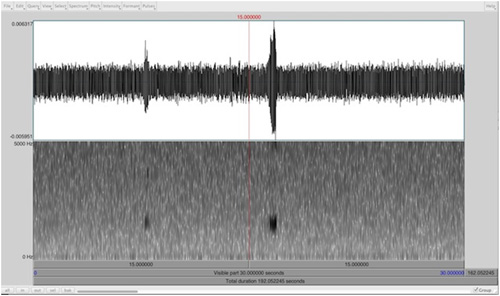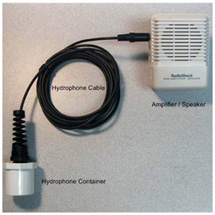 |
|
| SEARCH | UNDERWATER ACOUSTICS | ||||||
|
COSEE-TEK hosted a Teacher Technology Experience (TTE) in March 2012 working with Dr. Peter Scheifele from the FETCH~LAB, College of Allied Health Sciences & School of Medicine at the University of Cincinnati. The TTE engaged three teachers from the American School for the Deaf in West Hartford, CT and focused on acoustics and the technologies to measure sound in the ocean. Dr. Scheifele used to work at the Northeast Underwater Research, Technology & Education Center (NURTEC) and led the Center’s Bioacoustic Research Program that focused on a range of topics, including measuring ambient noise levels in the ocean and studying marine mammal behavior in response to both natural and anthropogenic noise. While at NURTEC, Dr. Scheifele was a Co-PI on the NSF-sponsored Classroom of the Sea project that worked closely with the teachers from ASD and other Schools for the Deaf. Evolving Simple Hydrophone Technology The TTE began by having the three teachers, Mary Laporta, Denise Monte and Betty Poster build their own hydrophones, using a highly modified version of a plans developed by Kevin Hardy at Scripps Institute for Oceanography at the University of California, San Diego (Hardy 2010). The goal of new design was to use only affordable, store-bought parts, eliminate the need for soldering in the classroom, and prevent leaks associated with oil-filled housings. COSEE-TEK Technicians (Kevin Joy and John Hamilton) reviewed the Hardy design and made iterative modifications based upon the teachers’ feedback to simplify the construction of hydrophones in a classroom environment. The final COSEE-TEK hydrophone design and material list can be found here (Version 4 - Modified for MaTTS, 06/15/2014). Sequential Testing After a couple hours of building the hydrophones, the teachers had the chance to test the fruits of their labor – first in UConn’s aluminum test tank using a desktop computer and free, open source software to record the sounds of tapping metal against the sides of the tank. All units tested successfully. The next step was to try to record ambient noise off UConn’s dock. The units were able to pick up sounds in the water, but the sound pressure level was low since these simple units had no pre-amplifier installed. The figure below illustrates the sound wave that one of the hydrophones recorded from banging on a pipe approximately 0, 1, 2 and 3 feet away from the hydrophone. There was a notable decrease in sound pressure as the source of the sound was pulled away from the hydrophone. 
Biological Testing – the Beluga Tank at Mystic Aquarium The next day COSEE-TEK descended upon the Mystic Aquarium to test their hydrophones in a more real-world setting with resident beluga whales in the Arctic Coast outdoor exhibit. Participating teachers had the unique opportunity to use their self-built hydrophones and Dr. Scheifele’s professional grade hydrophones to record marine mammal vocalizations throughout the rest of the day. Detailed logs were kept of which digital recorder was used with which hydrophone throughout the day. Analyzing the Sounds The final step was to analyze the recordings to: 1) ascertain how well the home-made hydrophones worked in a real world setting to record cetacean vocalizations and to visualize and classify the range of vocalizations produced by beluga whales at the Mystic Aquarium and Institute for Exploration based on first and second formants and spectral contour. Among the suite of software that Dr. Scheifele uses is a freely downloadable, multiplatform (PC, Mac, Linux) speech analysis program called Praat, developed by Paul Boersma and David Weenink from University of Amsterdam, the Netherlands (http://www.fon.hum.uva.nl/praat/). The Praat software opens the .wav file and allows viewing of both a waveform and spectrogram. The file can quickly be reviewed for events or other sound anomalies. The image below is a screen capture of the Praat software that shows two beluga whale grunts recorded at the Mystic Aquarium using the modified COSEE-TEK hydrophone. 
A more detailed analysis of the .wav files was conducted that included an analysis of “formants”. A formant is defined as “The spectral peaks of the sound spectrum of the voice; it represents the acoustic resonance of the vocal tract of an animal or human voice.” (http://www.phys.unsw.edu.au/jw/formant.html). Formants are utilized in phonetic research to analyze human speech, especially vowel sounds. They can however, provide insights into all sounds, including frequency intensities, shape profiles of the sound etc. which can be used as a first order approach to distinguishing and categorizing sounds. Educational Resource Development The teachers from the American School for the Deaf are now in the process of developing lesson plans that can be used by educators of the Deaf and hard of hearing, but also can have broader application. The lesson plans will developed that focus on: 1) how to build a COSEE-TEK version of a hydrophone, 2) activities that use the hydrophones to demonstrate the fundamentals of sound, and 3) how to use the Praat software to analyze a range of sounds including whales and other ocean sounds that will be available on the COSEE-TEK website. Additional Resources Facility for Education and Testing of Canine Hearing and Laboratory for Animal Bioacoustics (FETCH~LAB). University of Cincinnati. http://fetchlab.org/ (April 2012). Discovery of Sounds in the Sea (DOSITS). University of Rhode Island. http://www.dosits.org/ (April 2012). Fox, C. (2006) Technologies for Ocean Acoustic Monitoring. NOAA, Office of Ocean Exploration and Research. http://oceanexplorer.noaa.gov/technology/tools/acoustics/acoustics.html (April 2012). |







